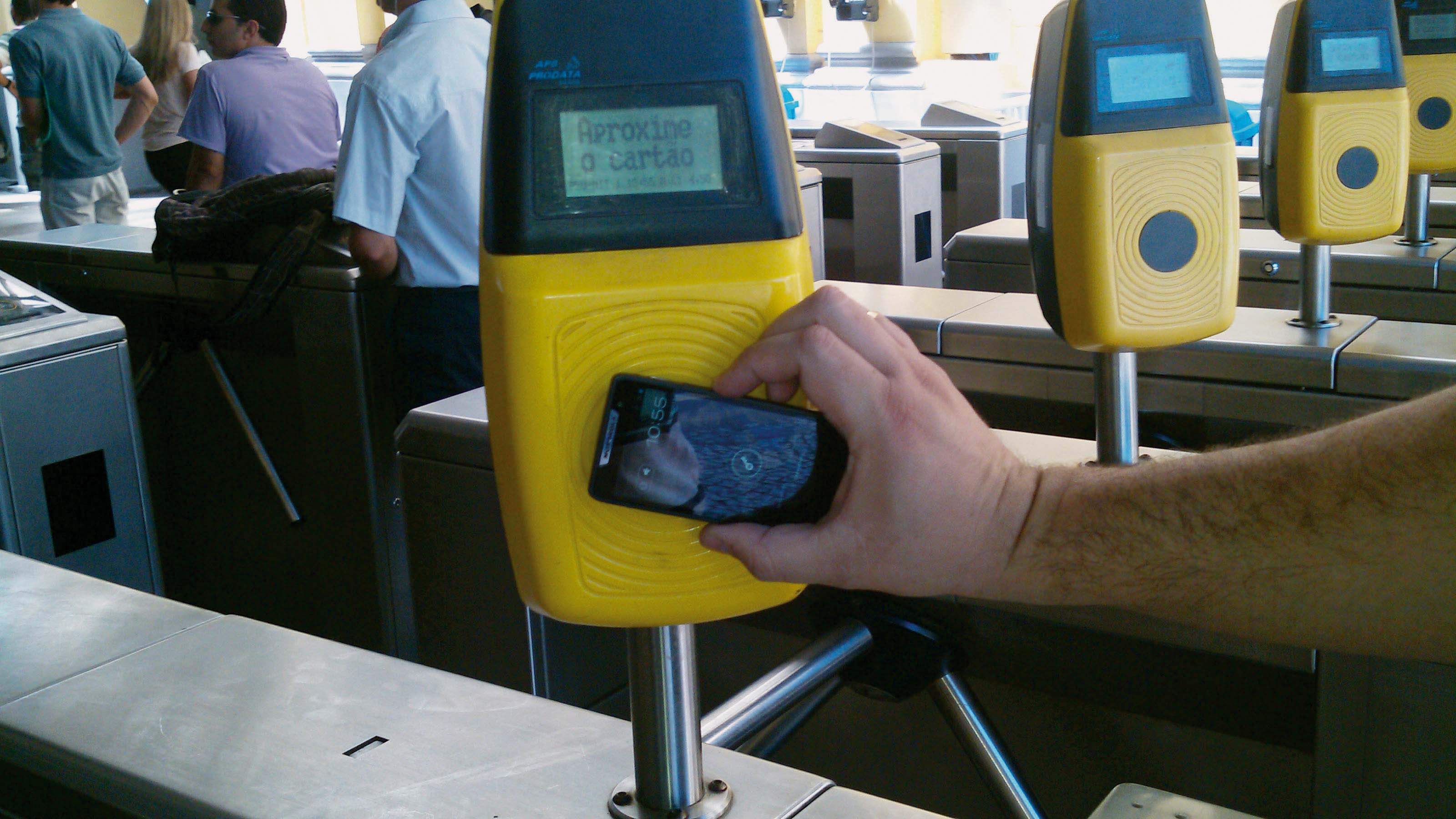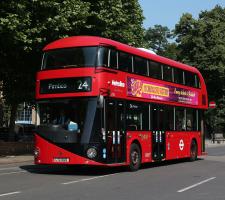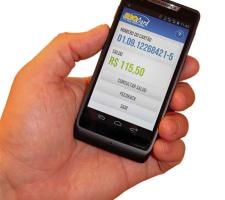
Validation in the Rio de Janeiro pilot
David Crawford reviews developments in near field communications for mass transit payments.
‘A carefully-designed and well-implemented mobile near field communications (NFC) solutions can give passengers a compelling experience that will encourage them to make greater use of public transport.’ That was the confident conclusion of a recent joint White Paper drawn up by the3833 International Association of Public Transport and the global mobile operators’ representative group 2246 GSMA.
The white paper, entitled Mobile NFC in Transport, highlights benefits including greater passenger convenience along with lower sales and distribution costs for operators. Other benefits highlighted were accurate, transparent and low-cost ticket validation along with more flexible and interoperable ticketing which it says could eventually pave the way for complete, integrated intermodal solutions.
Driving interest in this area is the growing availability of NFC handsets, with more than 200 million phones of over 70 types currently in use worldwide and industry forecasts are that by 2015, half of new smart phones will support NFC. By that time it predicts mobile phones sold in Europe will be smart phones.
The 2013 update from Pew Research Center’s Internet & American Life Project shows that most Americans (56%) now own a device. More detailed results from the public policy fact tank indicate ‘a very strong correlation’ between transit ridership profiles and market segments with high percentages of smart phone ownership.
Transit technology suppliers limbering up to exploit these upward trends include
378 Cubic Transportation Systems, which took advantage of the September 2013 annual meeting of the American Public Transportation Association to launch its NextWave Mobile Business System platform. This aims to reduce the complexity of deployment by equipping transit agencies to introduce branded apps.
In a recent two-month trial of the technology, passengers paid fares, checked card balances and accessed their travel and transaction histories directly through a mobile app running on both493 Apple and 1812 Android devices. The platform/app combination provided connectivity with the agency’s back office, effectively making the mobile phone an integrated terminal on the fare system network – replicating equivalent in-station vending machines and on-bus travel card validators. Cubic has demonstrated NFC-based transit fare applications with passengers in San Francisco, Frankfurt, Los Angeles, and San Diego.
Further south in Latin America, Rio de Janeiro has become the first city in Brazil to launch a pilot programme using mobile NFC ticketing to pay for public transport use at RioCard reader terminals. The scheme is a partnership between RioCard Tecnologia da Informação, digital security specialist3866 Gemalto, 1691 Google-owned 96 Motorola Mobility and Brazil’s four leading mobile operators - supported by trade body the GSMA.
Rio’s pilot involves 200 bus, rail and ferry passengers in a three-month trial, due to end in December 2013. RAZR D3 smartphones from Motorola work as mobile wallets. The embedded NFC technology is a major step forward from the city’s 2003 introduction of contactless payment with the RioCard.
Digital security specialist Gemalto is supplying its UpTeq multi-tenant NFC SIM cards, introduced specifically to support mass deployment of mobile ticketing, with embedded Mifare4Mobile technology, initially developed by5460 NXP Semiconductors. GemaltoBrazil’s telecom director Damien Bullot points to the potential for later implementation of its Trusted Service Manager (TSM) platform to deliver value-added services.
The same company has worked with Hong Kong mobile network operator PCCW-HKT Octopus Cards Ltd (OCL) to enable subscribers to load Octopus payment functions onto their mobile NFC devices to pay fares. The company claims its Octopus Mobile Payment Service is the world’s first commercial SIM-based implementation on NFC SIM cards of576 Sony’s FeliCa technology.
Meanwhile, Japan’s largest mobile service provider,7342 NTT DoCoMo, is working with South Korean operator KT on the development of cross-border services between the two countries, with further plans to expand its NFC Service Roaming more widely across Asia. The currently most popular NFC services in South Korea today are transport-related, with more than two million people using their mobile handsets to pay their multimodal fares, mostly in the capital, Seoul.
In Europe, public calls for tenders for fare-payment upgrades in France are now encouraging the use of NFC-compliant phones. In 2010,4186 Xerox announced the roll-out of the technology across the Nice public transport network and more than 6,000 commuters are now using 1809 Samsung Player One smartphones to take advantage of it. In January 2011, the French Minister for Industry, Energy and the Economy launched a programme to introduce the system to eight other cities: Bordeaux, Caen, Lille, Marseille, Paris, Rennes, Strasbourg and Toulouse.
Strasbourg’s U’Go system runs fully online with tickets located on the servers of local operator, Compagnie des Transports Strasbourgeois, and not on the handset thereby allowing this to be used by a number of passengers. The operator puts the cost of this ‘NFC evolution’ at some €1 million (US$1.35 million), 10% of the cost for a complete renewal of the its ticketing system.
But one major European transit operator,1466 Transport for London (TfL), remains cautious about NFC, despite the December 2012 launch of contactless payment card (CPC) capability on the city’s buses – which has now been used to pay for more than five million journeys. TfL plans a rollout to other travel modes during 2014, in a phased replacement of its proprietary Oyster product.
A TfL spokeswoman told1846 ITS International: “With the technology developed for CPC acceptance, we can move away from a current card-centric system to a back-office one, which will provide enhanced functionality, particularly around mobile and internet purchase. We have looked at mobile payment technology and continue to watch with interest how this develops elsewhere.
“Our upgrade to readers across the network makes them capable of accepting suitable payment applications on mobile phones. Providing that these meet industry standards and enable sufficiently fast transaction speeds, we would welcome their use in the future.”
London’s bus network has already been the subject of a consultation on removing the option for cash fare payments. Withdrawal of roadside ticket machines, which are now only used on average only once an hour, will save £1.9 million (US$3.06 million) per year in maintenance.
However, the availability of smart phones is only one part of the equation as many mobile phone network operators are not currently planning on making the NFC transport application a standard feature on all their SIM cards.
Again, there is the question of the readiness of transit operators for NFC take-up – as stressed by Dr Peter Harrop, of European emerging technology business research group6582 IDTechEX. In his newly-published review of the NFC market from 2014-2024, he comments that, while many of the world's transportation access systems are now NFC-compatible and that considerable infrastructure is already in place, deployment is slow.
“We do not think that NFC will play a major percentage part in payments and ticketing until near the end of the coming decade”, he says. One issue is “the speed-of-transaction problem with some solutions”.
Points that the International Association of Public Transport and trade body the GSMA highlight for optimum rollout include recognition of transit agencies’ financial constraints and need to minimise disruption – especially as installed validation equipment tends to have 10- to 20-year lifecycles. Therefore, many mobile NFC solutions will either have to work with the existing infrastructure or wait for its lifecycle to expire.
The two groups go on to suggest that it could be useful if NFC handsets were to be shipped with relevant transport apps pre-installed. This could be of benefit to smaller transit operators who, they suggest, should also consider joining forces to gain contractual and technical advantages, and appointing joint systems integrators/aggregators to manage the distribution of apps.
For the bus industry, they note a positive correlation between how fast people can board and how many buses are needed in a fleet, saying: “A fast throughput can save the transport operator significant amounts of capital and operational costs.” Not least, they highlight the fact that using NFC handsets to store and validate transport tickets or equivalents will automatically create a digital record of the travel being undertaken. Subject to data protection laws, the transport operator could then use the detailed, but anonymised, data captured by electronic ticketing to monitor congestion, understand passenger journey patterns and trends as well as to plan enhancements to services or the infrastructure.
Specifically, this data could be used proactively to direct passengers that regularly use a particular route away from temporarily congested stations by sending out text messages. These alerts could go on to offer travellers a discount for alighting at an alternative stop nearby, which they would gain automatically when touching off on arrival.
‘A carefully-designed and well-implemented mobile near field communications (NFC) solutions can give passengers a compelling experience that will encourage them to make greater use of public transport.’ That was the confident conclusion of a recent joint White Paper drawn up by the
The white paper, entitled Mobile NFC in Transport, highlights benefits including greater passenger convenience along with lower sales and distribution costs for operators. Other benefits highlighted were accurate, transparent and low-cost ticket validation along with more flexible and interoperable ticketing which it says could eventually pave the way for complete, integrated intermodal solutions.
Driving interest in this area is the growing availability of NFC handsets, with more than 200 million phones of over 70 types currently in use worldwide and industry forecasts are that by 2015, half of new smart phones will support NFC. By that time it predicts mobile phones sold in Europe will be smart phones.
The 2013 update from Pew Research Center’s Internet & American Life Project shows that most Americans (56%) now own a device. More detailed results from the public policy fact tank indicate ‘a very strong correlation’ between transit ridership profiles and market segments with high percentages of smart phone ownership.
Transit technology suppliers limbering up to exploit these upward trends include
In a recent two-month trial of the technology, passengers paid fares, checked card balances and accessed their travel and transaction histories directly through a mobile app running on both
Further south in Latin America, Rio de Janeiro has become the first city in Brazil to launch a pilot programme using mobile NFC ticketing to pay for public transport use at RioCard reader terminals. The scheme is a partnership between RioCard Tecnologia da Informação, digital security specialist
Rio’s pilot involves 200 bus, rail and ferry passengers in a three-month trial, due to end in December 2013. RAZR D3 smartphones from Motorola work as mobile wallets. The embedded NFC technology is a major step forward from the city’s 2003 introduction of contactless payment with the RioCard.
Digital security specialist Gemalto is supplying its UpTeq multi-tenant NFC SIM cards, introduced specifically to support mass deployment of mobile ticketing, with embedded Mifare4Mobile technology, initially developed by
The same company has worked with Hong Kong mobile network operator PCCW-HKT Octopus Cards Ltd (OCL) to enable subscribers to load Octopus payment functions onto their mobile NFC devices to pay fares. The company claims its Octopus Mobile Payment Service is the world’s first commercial SIM-based implementation on NFC SIM cards of
Meanwhile, Japan’s largest mobile service provider,
In Europe, public calls for tenders for fare-payment upgrades in France are now encouraging the use of NFC-compliant phones. In 2010,
Strasbourg’s U’Go system runs fully online with tickets located on the servers of local operator, Compagnie des Transports Strasbourgeois, and not on the handset thereby allowing this to be used by a number of passengers. The operator puts the cost of this ‘NFC evolution’ at some €1 million (US$1.35 million), 10% of the cost for a complete renewal of the its ticketing system.
But one major European transit operator,
A TfL spokeswoman told
“Our upgrade to readers across the network makes them capable of accepting suitable payment applications on mobile phones. Providing that these meet industry standards and enable sufficiently fast transaction speeds, we would welcome their use in the future.”
London’s bus network has already been the subject of a consultation on removing the option for cash fare payments. Withdrawal of roadside ticket machines, which are now only used on average only once an hour, will save £1.9 million (US$3.06 million) per year in maintenance.
However, the availability of smart phones is only one part of the equation as many mobile phone network operators are not currently planning on making the NFC transport application a standard feature on all their SIM cards.
Again, there is the question of the readiness of transit operators for NFC take-up – as stressed by Dr Peter Harrop, of European emerging technology business research group
“We do not think that NFC will play a major percentage part in payments and ticketing until near the end of the coming decade”, he says. One issue is “the speed-of-transaction problem with some solutions”.
Points that the International Association of Public Transport and trade body the GSMA highlight for optimum rollout include recognition of transit agencies’ financial constraints and need to minimise disruption – especially as installed validation equipment tends to have 10- to 20-year lifecycles. Therefore, many mobile NFC solutions will either have to work with the existing infrastructure or wait for its lifecycle to expire.
The two groups go on to suggest that it could be useful if NFC handsets were to be shipped with relevant transport apps pre-installed. This could be of benefit to smaller transit operators who, they suggest, should also consider joining forces to gain contractual and technical advantages, and appointing joint systems integrators/aggregators to manage the distribution of apps.
For the bus industry, they note a positive correlation between how fast people can board and how many buses are needed in a fleet, saying: “A fast throughput can save the transport operator significant amounts of capital and operational costs.” Not least, they highlight the fact that using NFC handsets to store and validate transport tickets or equivalents will automatically create a digital record of the travel being undertaken. Subject to data protection laws, the transport operator could then use the detailed, but anonymised, data captured by electronic ticketing to monitor congestion, understand passenger journey patterns and trends as well as to plan enhancements to services or the infrastructure.
Specifically, this data could be used proactively to direct passengers that regularly use a particular route away from temporarily congested stations by sending out text messages. These alerts could go on to offer travellers a discount for alighting at an alternative stop nearby, which they would gain automatically when touching off on arrival.








